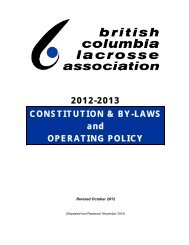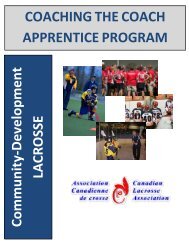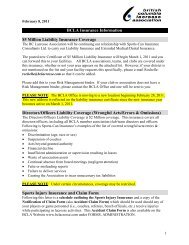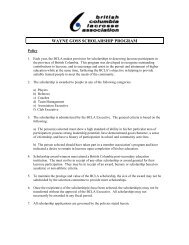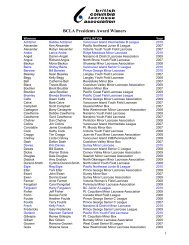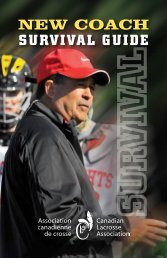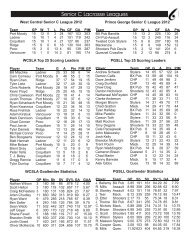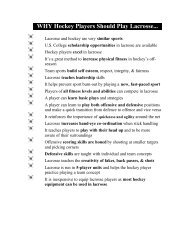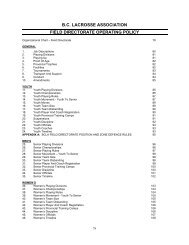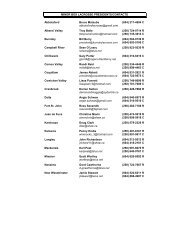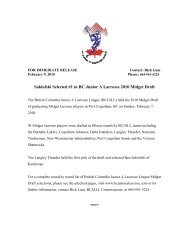Download - BCLA
Download - BCLA
Download - BCLA
You also want an ePaper? Increase the reach of your titles
YUMPU automatically turns print PDFs into web optimized ePapers that Google loves.
Fall 2012 Page 18<br />
Coaching TIPS 101<br />
Field Goaltending<br />
By: Jeff Gombar<br />
With over 300 Canadian athletes competing<br />
in NCAA Division I, II, and III lacrosse<br />
programs, there is a heightened awareness to<br />
better train our athletes in preparation for the<br />
grueling college lacrosse recruitment process.<br />
Similar to box lacrosse coaches, field lacrosse<br />
coaches look to increase their knowledge to best<br />
prepare their athletes for the field of play. With<br />
additional resources, one can continually learn,<br />
become a better coach and make the lacrosse<br />
experience a lasting one!<br />
Field lacrosse continues to be the fastest<br />
growing sport in North America, albeit mainly<br />
to the explosion of the sport south of the border.<br />
More and more, less traditional schools are starting<br />
new lacrosse programs at schools you would<br />
least expect, with majority of these institutions<br />
starting up new women’s lacrosse programs.<br />
The opportunities for our athletes to play NCAA<br />
college lacrosse are endless!<br />
Our latest topic will be on field lacrosse goaltenders.<br />
Much like box goaltenders, field goaltenders<br />
training tends to get overlooked when<br />
a roster includes approximately twenty players<br />
and one goaltender.<br />
It is imperative that field coaches just don’t<br />
throw the goalie in the net and leave them to<br />
field hundreds of unrealistic shots – many of<br />
the type of shots that would not be faced in real<br />
game action.<br />
This discipline requires so much more teaching<br />
between the pipes than simply placing a<br />
well-padded body in a 4 by 4 net. Can you<br />
imagine telling someone to fix a leaky faucet<br />
without any tools? Similarly, can you imagine<br />
how a goalie feels being thrown into the goal<br />
without the proper tools on how to stop a ball?<br />
We need to give field goalies direction on how<br />
to play the position to make this experience a<br />
positive one.<br />
Role of the goaltender. The goaltender is the<br />
most important position on any team. Goaltenders<br />
are a Stopper (save the ball); a Communicator<br />
(extra set of eyes for the defense); a Defender<br />
( loose balls and passing for transition);<br />
and the last line of defense (the ball stops here).<br />
Goalies are human and will make mistakes like<br />
any player on your team, but we all notice when<br />
a goal is scored because the ball gets past the<br />
goalie. Remember it is a team game!<br />
Coaches Corner<br />
Wheelchair Lacrosse<br />
By: Duane Bratt, CLA National Resource<br />
Person<br />
In the course of recent decades, a vast array of<br />
sports and physical activities traditionally available<br />
only to able-bodied athletes have become<br />
accessible to persons with disabilities at both<br />
the recreational and competitive levels. Some<br />
individuals may have been born with a congenital<br />
disability, while others may have acquired<br />
their disabilities later in life. Regardless of the<br />
origin of their ability or disability, Canadians<br />
who pursue sport and physical activity deserve<br />
to have a pathway to help them achieve their<br />
goals, whether they pursue excellence and high<br />
performance or simply aim to be active for life.<br />
Unfortunately, there are few, if any, opportunities<br />
for disabled athletes to play lacrosse. This is<br />
why the CLA is designing a wheelchair lacrosse<br />
program.<br />
Wheelchair lacrosse was developed in San<br />
Diego by a group that calls itself the National<br />
Wheelchair Lacrosse Association (NWLA). It<br />
uses wheelchair basketball chairs and is a fusion<br />
of box and field. The game is played 7-on-7 and<br />
uses a standard hockey net. It currently uses<br />
field rules with as few modifications to able-<br />
A good start to basic goaltending is with the<br />
stance (or ready position) and on stopping the<br />
ball (step, body and balance). The stance, or<br />
ready position, can be mastered with practice<br />
and must become automatic. Without a proper<br />
stance, a goaltender will be ineffective. The<br />
proper stance is an open, comfortable position<br />
allowing quick free movement.<br />
Let’s break down the parts of the body<br />
and how the stance best works. The feet are<br />
shoulder width apart (or the width of the goal<br />
stick head apart) and standing on the balls of<br />
the feet (neither toes nor heels) with the toes<br />
slightly pointed out. The knees are slightly<br />
bent with the back erect with shoulders square<br />
to the shooter. Arms are loose and away from<br />
the body with elbows pointing out away from<br />
body. The goalies head is up and the eyes<br />
should line up with your top hand with the<br />
thumb always pointing to the ball.<br />
When holding the stick, grip the shaft with<br />
both hands and hold the stick in front of body<br />
angled slightly across the body to the left or<br />
right side of the goaltender’s head (depending<br />
left or right handed). Place the top hand on the<br />
shaft near the neck of the stick and the bottom<br />
hand 8-10 inches from the butt end of the stick<br />
(nipple distance apart is a good gauge). Turn<br />
the hands on shaft so you can “point” your index<br />
fingers at a shooter. Be sure the wrists are<br />
behind the shaft with the top hand at eye level<br />
and the thumb pointing at the ball in the shooters<br />
stick – the bottom hand out on the stick is<br />
slightly angled out from the body out front of<br />
the top hand (butt end away from body). Ask<br />
your goalie to “tell time” to confirm bottom<br />
hand is out enough to be able to read a watch.<br />
Each goalie has their own comfort zone and<br />
the way they face the ball. But if you continually<br />
remind the goalie about EYE, THUMB,<br />
BALL, their stance and stick positioning will<br />
be in fine shape.<br />
Proper placement of the head of the stick is<br />
so important in order to cover as much of the<br />
goal area as possible. In the ready position, the<br />
head should not be high above the cross-bar or<br />
to the side of the body outside the posts or even<br />
in front of the goaltender’s body. The head of<br />
the stick needs to be placed to the left or right<br />
of the ear and slightly away from the body.<br />
This offers the maximum area of the goal to be<br />
covered by the head and in a great position to<br />
react to any high or low shot, let alone pass and<br />
catch the ball between defenders.<br />
bodied rules as possible: 2 attack, 2 defence,<br />
2 midfielders, and 1 goalie are used; off sides<br />
apply just like in field lacrosse; the nets are<br />
moved farther from the boards than in hockey<br />
or box lacrosse to allow for more room to move<br />
behind the net (a common strategy in field<br />
lacrosse); fouls are similar to field lacrosse;<br />
goalie wears field goalie equipment. Although,<br />
the CLA recommends that box goalie equipment<br />
is used instead; a no-bounce indoor ball is<br />
used; a regular head is placed on a goaltender<br />
shaft for defensemen so they can have longer<br />
sticks, similar to long poles in field; and carpenter<br />
kneepads are put on top of the knees to<br />
protect them from slashing.<br />
Other characteristics include: officials are<br />
not necessarily in wheelchairs; strategies are<br />
adapted from basketball, box lacrosse, and field<br />
lacrosse; lots of passing and catching on the<br />
fly; and there is currently no formal coaching<br />
development system.<br />
In 2011, a group from the NWLA played<br />
two exhibition games at the Ontario Lacrosse<br />
Festival against able-bodied teams (Six Nations<br />
Arrows and NLL All-stars). As a result, there<br />
is now a group in Ontario that is promoting<br />
wheelchair lacrosse. The target audience is<br />
Field Lacrosse Goaltenders<br />
face an average of 30-45<br />
shots directed towards the<br />
goal with only 15-25 shots on<br />
the goal per game.<br />
Stopping the ball. Now that your goalie has a<br />
good solid stance, let’s stop the ball. Goaltenders<br />
use their body and stick to stop the ball, however,<br />
it is important to understand how and when to<br />
use the different body parts and stick to block<br />
shots. Stopping the ball originates from the ready<br />
position moving in a lateral manner to ones left<br />
or right to get in the path of the ball being shot<br />
at the net. First and foremost, shots should be<br />
stopped with the stick.<br />
The goalie must be in the ready position like a<br />
coiled spring ready to uncoil and attack the ball.<br />
Always lead with the hands, punch your top and<br />
bottom hands out and step towards the trajectory<br />
of the ball (left side or right). All shots should be<br />
initially stopped with the stick and back yourself<br />
up with the body. Once the step motion starts the<br />
body must follow and maintain a square position<br />
to the ball in order to block the ball if not successful<br />
with the stick. It is important to maintain<br />
balance staying on two feet in order to react to a<br />
pass, rebound or another shot.<br />
Goaltenders face both high and low shots.<br />
High shots are similar to playing pass with the<br />
opponent. The goalie should anticipate the trajectory<br />
the ball will travel, step to that area, lead<br />
with the hands and meet the ball with the head<br />
of the stick. A key to the success of this is to follow<br />
the ball in the opponent’s stick to anticipate<br />
where the ball will travel.<br />
Low shots or bounce shots are the most difficult<br />
for goaltenders to stop. The goalie must<br />
step to the area where the ball makes contact with<br />
the ground -- punch the top hand toward the ball,<br />
place the head of the stick into the ground while<br />
keeping the shaft at an 80 degree angle towards<br />
the shooter. This allows for the ball to deflect<br />
into the ground, rather than back into play. The<br />
eyes must follow the ball into the stick, the body<br />
stays square to the ball and the goaltender must<br />
keep balanced on two feet. The goaltender must<br />
keep their head down and eyes on the ball in order<br />
to follow the ball into their stick or body.<br />
wheelchair basketball players and former lacrosse<br />
players. The game is played by late teens<br />
and adults.<br />
The CLA’s first objective is to create awareness<br />
in Canada of wheelchair lacrosse. The second<br />
objective is to develop a codified rule book.<br />
The third objective is to develop a coaching program<br />
within Canada’s NCCP for wheelchair lacrosse.<br />
Coaches who are unfamiliar with disabilities<br />
frequently lack confidence in their ability to<br />
support athletes with disabilities. These coaches<br />
especially need the support of the CLA and MA/<br />
AMAs to gain the knowledge, skills, techniques<br />
and confidence required to work effectively with<br />
LacrosseTalk British Columbia Lacrosse Association<br />
Photos: Jim Gow<br />
Advertise with us!<br />
Last pointer -- if the shooter’s stick is in a<br />
high position, the shot will likely be to the upper<br />
areas of the net; conversely, if the stick is in a<br />
low position, the shot will likely be to the lower<br />
areas of the net or a bounce shot. Remember the<br />
words STEP, BODY, BALANCE as a reminder<br />
in stopping the ball!<br />
The final point I’d like to drive home is the<br />
importance of warming up your goaltender correctly<br />
and in a systematic manner to best prepare<br />
them for practices and games. It is not like box<br />
lacrosse where the goaltender fields numerous<br />
shots in the team warm up, rather a planned<br />
amount of every type of shot until the goalie<br />
feels ready. Let the goaltender take as many<br />
shots necessary for preparation and let them tell<br />
the coaches when they’ve had enough. Let’s<br />
face it, most field lacrosse goalies face maybe<br />
20-25 shots in a game – let’s prepare them accordingly!<br />
Here is the perfect goalie warm-up to best<br />
prepare your goaltender. Use only one or two<br />
coaches to shoot balls with numerous balls lined<br />
up about 15 yards from net. No players are<br />
needed as they too have their set warm up plan.<br />
The coaches should shoot balls so the goalie<br />
stops every single shot. This will give the goalie<br />
a sense they are stopping many balls and feeling<br />
positive. Start shooting balls in a sequence<br />
10-15 shots per area then switch. The goalie<br />
dictates where he/she wants the ball thrown<br />
starting with stick side high, off stick side high,<br />
stick side hip, off stick side hip, low shot (not<br />
bouncing) and bounce shots.<br />
Stationary shots can be taken on a 12-15<br />
yard arc from left to right from different spots<br />
on the field (on the arc) in order for the goalie<br />
to expereince shots from all over the field of<br />
play – just like in a game. Then the coaches can<br />
advance to shots on the run for more game-like<br />
shots all the time increasing the velocity, angles<br />
and types of shots. The last type of shots that<br />
are beneficial are short feeds from a position<br />
behind the net (like an attackman) to a position<br />
in front of the net so the goalie reacts to a pass<br />
and prepares for a quick shot on goal – again<br />
simulating game-type shots.<br />
The players will tend to have passing and<br />
shooting drills of which the goalie can choose<br />
to join in (or not). They can also stay loose by<br />
joining in the player line drills if necessary.<br />
These pointers will be very beneficial in<br />
any goaltender’s development, young or<br />
old, male or female. Let’s just remember<br />
coaches, plan your field time accordingly<br />
with your goaltender(s) in mind. Good luck<br />
and good saving!<br />
athletes with disabilities. Coaches should be<br />
versed in sensitization tips and techniques for<br />
introducing persons with a disability to sports<br />
and physical activity. They must display positive<br />
attitudes towards persons with a disability and<br />
have strong instructional and interaction skills.<br />
They must be able to create a positive learning<br />
environment, be aware of different learning<br />
styles, and able to adapt equipment, skills, and<br />
rules to get individuals with disabilities more<br />
actively engaged in lacrosse.<br />
By creating a lacrosse program for athletes<br />
with a disability, we ensure that lacrosse is truly<br />
for everyone.<br />
*Tournaments* Retailers * FundRaisers* Camps*<br />
For details contact Jeff at:<br />
jeff@bclacrosse.com or 604-421-9755



